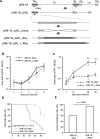Amino acid insertion in the Meq protein of Marek's disease virus, an avian oncogenic herpesvirus, accelerates tumorigenesis
- PMID: 40673706
- PMCID: PMC12323629
- DOI: 10.1128/spectrum.03368-24
Amino acid insertion in the Meq protein of Marek's disease virus, an avian oncogenic herpesvirus, accelerates tumorigenesis
Abstract
Marek's disease virus (MDV) causes lymphomas (Marek's disease) in chickens. Despite vaccination, MDV field strains exhibit increased virulence, and sporadic outbreaks are still reported. An insertion/deletion in Meq has been identified in several MDV strains, and our previous study using recombinant MDV (rMDV) demonstrated that an insertion in Meq enhanced MDV virulence, whereas a deletion reduced its virulence. However, the mechanisms by which these indels in Meq alter MDV virulence remain elusive. We aimed to clarify the impact of the insertion in Meq on pathogenesis. We compared the effects of Meq and Meq with the insertion, termed L-Meq, on transcriptional regulation, the dynamics of transformed T cells and relevant T-cell subsets, and the patterns of gene expression in tumor lesions of infected chickens. Reporter assays revealed that insertion increased the transactivation activity on the infected-cell protein 4 promoter in the MDV genome and bcl-2/cd30 promoters in the host genome. rMDV encoding L-Meq (vRB-1B_L-Meq) exhibited higher mortality and tumor incidence than rMDV encoding Meq (vRB-1B_Meq), and vRB-1B_L-Meq infection increased the proportion of CD4+ T cells, which are targets for transformation by MDV, in the early post-infection phase, compared with vRB-1B_Meq. RNA-seq analysis revealed that similar genes were modulated in tumor lesions of chickens infected with vRB-1B_Meq or vRB-1B_L-Meq. These findings suggest that although the insertion in Meq does not alter the target genes for transcriptional regulation, it accelerates the process of tumorigenesis by enhancing the transactivation activity.IMPORTANCEMarek's disease, an avian lymphoproliferative disease, is caused by Marek's disease virus (MDV). Meq, an MDV oncoprotein, regulates the expression of viral and host genes. Meq with an insertion, termed L-Meq, has been identified as a factor that enhances MDV virulence. However, the mechanisms by which the insertion in Meq alters MDV virulence remain unknown. Our study clarified that the insertion enhances the transactivation activity of Meq on the host promoters related to tumorigenesis. Notably, the transcriptomes of tumor lesions in chickens infected with recombinant MDV (rMDV) with L-Meq and those infected with rMDV encoding Meq without the insertion were similar; however, chickens infected with rMDV harboring L-Meq exhibited higher proportions of CD4+ T cells and regulatory T cells, which are targets for transformation by MDV, in the early post-infection phase, suggesting accelerated tumorigenesis. This study contributes to the current understanding of the mechanisms underlying MDV virulence.
Keywords: L-Meq; Marek's disease; Marek's disease virus; Meq; insertion; transactivation activity; tumorigenesis; virulence.
Conflict of interest statement
The authors declare no competing interests.
Figures







Similar articles
-
The Meq Genes of Nigerian Marek's Disease Virus (MDV) Field Isolates Contain Mutations Common to Both European and US High Virulence Strains.Viruses. 2024 Dec 31;17(1):56. doi: 10.3390/v17010056. Viruses. 2024. PMID: 39861844 Free PMC article.
-
Marek's Disease Virus (MDV) Meq Oncoprotein Plays Distinct Roles in Tumor Incidence, Distribution, and Size.Viruses. 2025 Feb 14;17(2):259. doi: 10.3390/v17020259. Viruses. 2025. PMID: 40007015 Free PMC article.
-
Amino Acid Polymorphisms in the Basic Region of Meq of Vaccine Strain CVI988 Drastically Diminish the Virulence of Marek's Disease Virus.Viruses. 2025 Jun 26;17(7):907. doi: 10.3390/v17070907. Viruses. 2025. PMID: 40733525 Free PMC article.
-
The Black Book of Psychotropic Dosing and Monitoring.Psychopharmacol Bull. 2024 Jul 8;54(3):8-59. Psychopharmacol Bull. 2024. PMID: 38993656 Free PMC article. Review.
-
Latency and tumorigenesis in Marek's disease.Avian Dis. 2013 Jun;57(2 Suppl):360-5. doi: 10.1637/10470-121712-Reg.1. Avian Dis. 2013. PMID: 23901747 Review.
References
MeSH terms
Substances
Grants and funding
LinkOut - more resources
Full Text Sources
Research Materials

